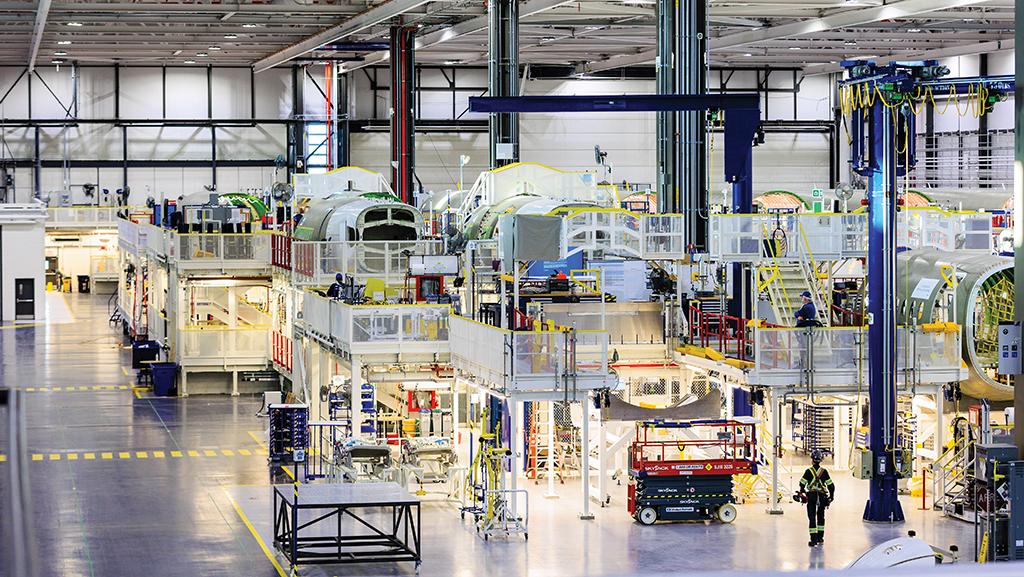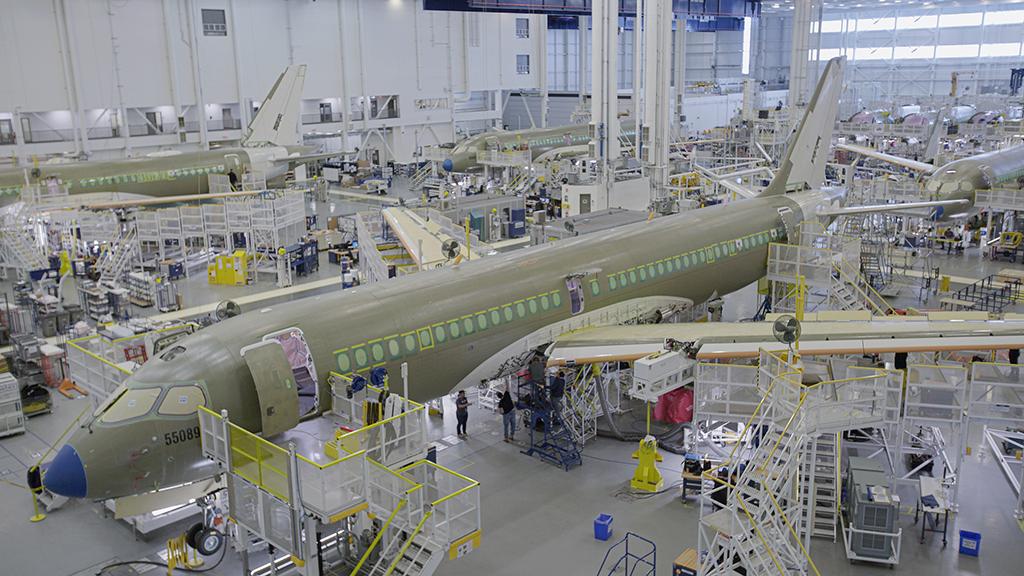
Airbus has moved up fuselage equipping work in the production stream to make final assembly more resilient.
In the narrowbody market, the unbalanced competitive landscape between the Airbus A320neo and the Boeing 737 MAX families is currently very much in the foreground. As the Airbus A220 program is grabbing less attention, the multinational OEM is now laying the groundwork for the A220 to be able to step up and make Boeing’s position even more defensive.
Often ridiculed as a “nice little aircraft” by former Airbus Chief Commercial Officer John Leahy, the former Bombardier C Series program had been seen internally as a serious competitive threat to the A320 family and was the main reason behind Airbus’ decision to launch the reengined A320neo in 2010. When it became clear that Bombardier could no longer afford to maintain the program, Airbus acquired the former C Series in 2018, in what was seen as a clever strategic play by then-CEO Tom Enders. Airbus killed several birds with one stone: Taking control prevented a possible sale to China or Boeing, and the new aircraft type would open up new possibilities of attacking the 737 MAX from the lower end of the market.
- Airbus puts in place the basis for increased A220 production
- Long-range and stretched versions are on the horizon
- A220 could move up to compete in the A320neo and Boeing 737-8 market segment
But first, the program needed to be fixed.
Because of the high-risk competitive position of the C Series and the relatively low expected volumes, Bombardier had to agree to highly disadvantageous contracts with its major suppliers. Not only was the pricing much worse than that of any Boeing or Airbus program but Bombardier also outsourced much more aerostructure work in comparison with Airbus. After the takeover, Airbus set a target of reducing supplier costs by about 20%, and the company is still working toward that goal.
At the same time, production is set to more than double over the next three years. The three final assembly lines (FAL) in Mirabel, Canada, and Mobile, Alabama, are currently at a nominal production rate of six aircraft per month. Airbus plans to increase that rate by 2025 to a combined 14 aircraft, 10 of which are to be built on the two parallel lines in Mirabel. Also in 2025, the aircraft program is expected to reach an operating profit for the first time. Once that milestone is in sight, Airbus will look at the next potential steps—longer ranges and a stretched version that would essentially match the size of a 737-8 or A320neo.
Before Airbus takes those next steps, however, it is putting new structures in place—both in its relationship with suppliers and industrially.
“We are where we should be today,” says Airbus Canada CEO Benoit Schultz, referring to the renegotiated supplier deals. “Competitiveness of the supply chain is key, particularly at high rates.” He also indicates that Airbus is not going to stop at the initial 20% reduction target: “Tomorrow there is a need for more [reductions].”
Due to its Bombardier legacy, most of the A220’s aerostructure components are outsourced. For example, Spirit Aerosystems is building the wings and mid-fuselage; Stelia Aerospace (now Airbus Atlantic) is in charge of the cockpit and aft fuselage; Avic’s Shenyang Aircraft Corp. is building the forward, mid and aft fuselage sections as well as the doors and tailcone; and Aernnova Aerospace has a contract for the center wing box and tailcone. Some components are dual-source; others are not.

Although derisking is an important target, Schultz does not see “a need for radical change.” That also holds true for the large share that is placed into Avic Shenyang, which is delivering components “on time and on quality,” he says.
The same cannot be said for all component providers, and it shows in A220 deliveries. Airbus handed over a total of 39 A220s—six of which were A220-100s—in the first 10 months of the year, averaging less than four aircraft per month. More specifically, no aircraft were delivered in August, four were delivered in September and five in October.
“The line is at rate 6, but deliveries are not linear,” Schultz says. As a result, Airbus Canada continues to experience “some level of perturbation that has to do with the supply chain. We have adapted our plan tactically in line with suppliers.”
Schultz adds that there is not just one root cause or a systemic reason for the supply chain woes. The A220 program is “exposed to outstanding work”—meaning work that has not been completed where it should be—and Schultz expects that problem to persist “well into 2023.”
Like Airbus as a whole, the OEM’s Canadian subsidiary has started to increase the level of strategic buffer it has on hand to handle irregularities. The company is also implementing value stream management (VSM) more deeply as a steering principle in production to optimize the process. The unit has named Ivan Martinez as A220 head of VSM, reporting to Schultz and Chief Operating Officer Alberto Gutierrez.
Internally, Airbus Canada has also implemented major changes in the final assembly flow. It introduced a so-called pre-FAL in a hangar formerly used for the Bombardier CRJ program. The main idea of the rearrangement is to move system installation upstream in the process. The pre-FAL is a U-shape tacted line currently operating at rate 6. The equipped fuselage sections are then either moved to the local FAL in Mirabel or trucked to Mobile.
“This adds a layer of protection for the FAL,” says Daniel Wenniger, head of the A220 program office. “It started in January, and we can already see the benefits. We have a lot of stability.” If the process is disrupted, allowing some traveled work into the actual FAL is then less of an issue because the normal process is already more straightforward. In the pre-FAL, four stations are used for preparatory work and seven for the actual equipping.
The same work had previously been performed at temporary stations inside the FAL building, where there were constraints on space and customization was done very much downstream. The arrangement worked for the low production rates of two or three aircraft per month—the rate at which the program had operated initially and during the novel coronavirus pandemic—but that level of production would not suffice for the planned growth. “It allows a perfect industrial flow,” Wenniger says.
“The pre-FAL is a very important step for our rate capabilities,” Schultz says. “The more you can move upstream, the better for the process. We are taking advantage of the Airbus experience.”
The expanded industrial capabilities form the basis for Airbus to spool up deliveries as planned. The manufacturer has so far collected 788 firm orders for the A220, 692 of which are for the A220-300. By the end of October, 232 aircraft had been delivered. The production backlog is heavily tilted in favor of the A220-300; only 40 orders remain for the smaller and less economical -100.
Airbus has made clear several times that a further stretch of the aircraft is “a question of when, not if,” as Chief Commercial Officer Christian Scherer once put it. The exact timing has to do with several factors. For one, the company aims to gear up production first and make the program profitable before tasking the organization with another development program that will require more investment. The other elements taken into account are the competitive play against Boeing and, unfortunately for Airbus, the A320neo.
The A220-300 is currently certified for up to 150 seats, but Airbus is working on raising capacity to 160 passengers. A stretched version would safely move the aircraft into the A320neo and 737-8 territory of about 180 seats, presumably with much better economics. While Airbus might be tempted to launch the version early to target the most successful version of the 737 MAX family, it must also take into account the likely effect on sales of the highly profitable A320neo. The A320neo program is becoming “a very A321neo-centered family,” Schultz says. In fact, Airbus has 2,387 outstanding orders for the A320neo but 3,734 for the A321neo.
An A220-500, launched around 2025 and put into service 3-4 years later, would likely be an acceptable risk to the A320neo backlog, particularly since Boeing has made clear it will not launch a new narrowbody until after 2030. “The aircraft has a lot of potential,” Schultz says, but he has not specified a timeline, except to say that “now is not the time [for a launch decision].”
The other likely development is a long-range version of the A220-300. Breeze Airways founder David Neeleman has been pitching the idea to Airbus for years, since the extended range would allow his airline to fly transatlantic routes with the A220. Airbus increased the range of the aircraft once, in 2019, by 450 nm, and the A220-300 can now fly up to 3,400 nm. Neeleman, however, wants it to be capable of flying 4,000 nm—the same range as the A321LR but less than the A321XLR (4,700 nm).
Airbus could take advantage of work already performed for the corporate jet version of the A220, launched in 2020 and equipped with auxiliary fuel tanks. Such an aircraft would take the idea of long-haul narrowbody flight one step further and allow airlines to open up even thinner routes—but Airbus needs to consider whether adding that capability to the A220 would cannibalize the lower end of the A321XLR market.





Comments